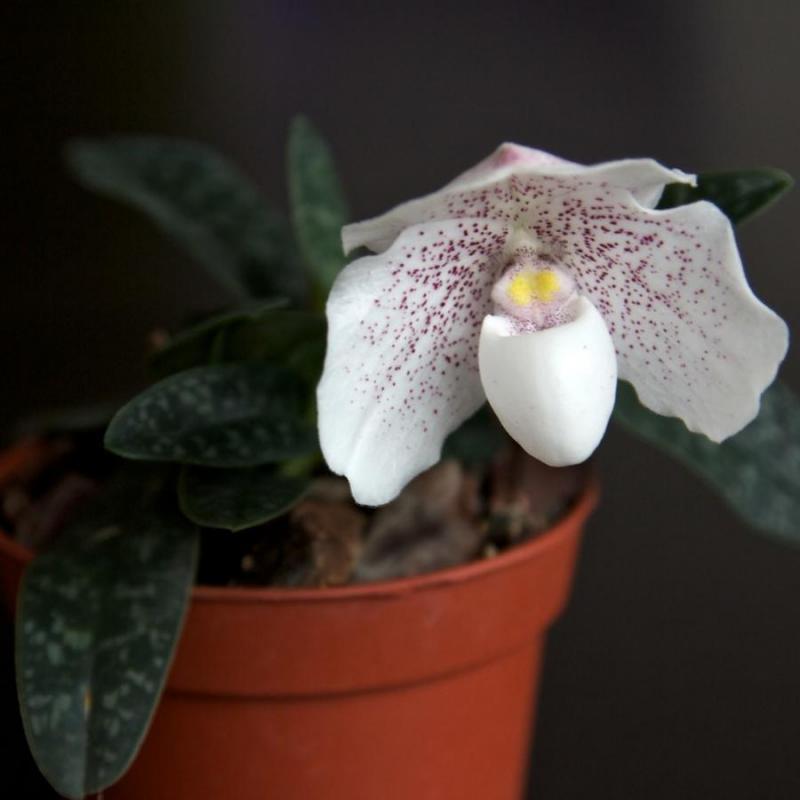Paphiopedilum niveum
Also known as: The Snow or Paphiopedilum niveum h.f. niveum Paphiopedilum niveum h.v. Ang Thong album Cypripedium niveum var. album Paphiopedilum niveum h.v. schneiderianum Cypripedium pereirae Paphiopedilum niveum h.v. ang thong Paphiopedilum niveum f. album Paphiopedilum pereirae Paphiopedilum niveum h.v. ang-thong Cordula nivea in the subfamily: Cypripedioideae
Native to: Singapore Thailand
General Information
The Snow is a dwarf warm growing terrestrial orchid belonging to the sub family Cypripedioideae native to Singapore and Thailand.
Plant Description
Grows to 26cm. Each new growth has numerous leaves that grow to 2.7-15cm long
Substrate(s)
- Coarse
Care Notes
These orchids grow on the forest floor so are used to rich soil containing plenty of organic matter that is always moist (but not always wet), and prefer constant conditions in terms of humidity, temperature and water supply. They may not be as forgiving as epiphytes in regards to sudden changes in growing conditions so it is wise to ease them into new conditions over a the space of a few days, and repot as infrequently as possible.
Keep an eye on the plants condition regularly as they can decline suddenly if the conditions are not just right. It is more important to keep water supply constant rather than frequent - overwatering often causes rot which can quickly set in, especially in warmer conditions.
These can be grown in shady, moist areas in the garden, supplied they have protection from abrupt changes caused by the elements, e.g. dry winds, frost etc. Being grown around companion plants such as ferns and bromeliads will help build and retain the humidity they require throughout the year.
Climate
Grows at low to high elevations. Rainfall ranges from 56mm to 325mm per day, heaviest in September and lightest in February. Humidity ranges from 66% to 84%, highest in October and lowest in February. Temperature ranges from 22C to 34C, highest in March (24C to 34C) and lowest in January (22C to 31C).
Watering
These orchids are sensitive to excessive watering and should only be watered when they look thirsty. Water infrequently and ensure that the roots are dry before watering. Keep an eye on them especially during hot weather as overwatering can lead to rot, whereas underwatering may result in wilting or shriveling, which while unattractive, will not kill the plant.
Fertiliser
These orchids do not need to be regularly fertilised and roots may be sensitive to salt build-up, dying back and therefore impairing the plants growth or even killing it.
If fertilising, use half to quarter of the recommended amount of fertiliser. If they receive fertiliser as part of a collection, be sure to flush out the pots regularly with fresh water and monitor the roots by checking how much resistance is given by the plant when nudged in its pot or mount. If the plant becomes wobbly or loose, repot in fresh mix or rinse the media/mount thoroughly and do not fertilise for at least 3 months.
Be sure to flush out excess fertiliser by running water through the media regularly year round. This plant is sensitive so apply fertiliser sparingly at one quarter recommended strength or less. Use a high Nitrogen fertiliser year round. Use a high Phosphorous fertiliser year round.Potting
Due to the growth nature of these plants they are best mounted onto cork, tree fern slabs, or even trees if the climate suits. Water regularly especially in hot weather.
Repotting is best done annually and after flowering.




















